Antibacterial Property and Cytotoxicity of a Poly(lactic acid)/Nanosilver-Doped Multiwall Carbon Nanotube Nanocomposite
Abstract
:1. Introduction
2. Experimental
2.1. MWCNT-Ag Synthesis
2.2. Preparation of PLA/MWCNT-Ag Nanocomposites
2.3. Thermogravimetric Analysis
2.4. Differential Scanning Calorimetry
2.5. Mechanical Properties
2.6. Antibacterial Evaluation
2.7. Energy Dispersive X-ray Spectrometery
2.8. In Vitro Cytotoxicity Test (ISO 10993-5)
2.9. Hydrolysis Test
2.10. Morphology Analysis
3. Results and Discussion
3.1. TGA
3.2. DSC
3.3. Tensile Properties
3.4. Antibacterial Evaluation
3.5. Elemental Composition of MWCNT-Ag and Distribution of Ag in the PLA/MWCNT-Ag Nanocomposites
3.6. Cytotoxicity Test
3.7. Hydrolysis of the PLA/MWCNT-Ag Nanocomposites
3.8. Morphology of PLA/MWCNT-Ag Nanocomposites after Hydrolysis
4. Conclusions
Supplementary Materials
Acknowledgments
Author Contributions
Conflicts of Interest
References
- Tsou, C.H.; Lee, H.T.; Tsai, H.A.; Cheng, H.J.; Suen, M.C. Synthesis and properties of biodegradable polycaprolactone/polyurethanes by using 2,6-pyridinedimethanol as a chain extender. Polym. Degrad. Stabl. 2013, 98, 643–650. [Google Scholar] [CrossRef]
- Anderson, J.M.; Shive, M.S. Biodegradation and biocompatibility of PLA and PLGA microspheres. Adv. Drug Deliv. Rev. 2012, 64, 72–82. [Google Scholar] [CrossRef]
- Tsou, C.H.; Kao, B.J.; Suen, M.C.; Yang, M.C.; Wu, T.Y.; Tsou, C.Y.; Chen, J.C.; Yao, W.H.; Chu, C.K.; Tuan, X.M.; et al. Crystallisation behaviour and biocompatibility of poly(butylene succinate)/poly(lactic acid) composites. Mater. Res. Innov. 2014, 18, 372–376. [Google Scholar] [CrossRef]
- Tsou, C.Y.; Wu, C.L.; Tsou, C.H.; Chiu, S.H.; Suen, M.C.; Hung, W.S. Biodegradable Composition of Poly(lactic acid) from Renewable Wood Flour. Polym. Sci. Ser. B 2015, 57, 473–480. [Google Scholar] [CrossRef]
- Tsou, C.H.; Hung, W.S.; Wu, C.S.; Chen, J.C.; Huang, C.Y.; Chiu, S.H.; Tsou, C.Y.; Lin, S.M.; Chu, C.K.; Hu, C.C.; et al. New composition of maleic-anhydride-grafted poly(Lactic Acid)/rice husk with methylenediphenyl diisocyanate. Mater. Sci. 2014, 20, 446–451. [Google Scholar] [CrossRef]
- Tsou, C.H.; Lee, H.T.; De Guzman, M.; Tsai, H.A.; Wang, P.N.; Cheng, H.J.; Suen, M.C. Synthesis of Biodegradable Polycaprolactone/Polyurethane by Curing with H2O. Polym. Bull. 2015, 72, 1545–1561. [Google Scholar] [CrossRef]
- Daniels, A.; Chang, M.K.; Andriano, K.P.; Heller, J. Mechanical properties of biodegradable polymers and composites proposed for internal fixation of bone. J. Appl. Biomater. 1990, 1, 57–78. [Google Scholar] [CrossRef] [PubMed]
- Tsou, C.H.; Suen, M.C.; Yao, W.H.; Yeh, J.T.; Wu, C.S.; Tsou, C.Y.; Chiu, S.H.; Chen, J.C.; Wang, R.Y.; Lin, S.M.; et al. Preparation and Characterization of Bioplastic-Based Green Renewable Composites from Tapioca with Acetyl Tributyl Citrate as a Plasticizer. Materials 2014, 7, 5617–5632. [Google Scholar] [CrossRef]
- Tsou, C.H.; Lee, H.T.; Hung, W.S.; Wang, C.C.; Shu, C.C.; Suen, M.C.; De Guzman, M. Synthesis and Properties of Antibacterial Polyurethane with Novel Bis(3-pyridinemethanol) Silver Chain Extender. Polymer 2016, 85, 96–105. [Google Scholar] [CrossRef]
- Tsou, C.H.; Suen, M.C.; Tsou, C.Y.; Chen, J.C.; Yeh, J.T.; Lin, S.M.; Lai, Y.C.; Hwang, J.Z.; Huang, S.H.; Hong, W.S.; et al. Argon plasma in a new process for improving the physical and anti-bacterial properties of crosslinked cotton cellulose with dimethyloldihydroxyethyleneurea-maleic acid. Fibers Text. East. Eur. 2015, 23, 49–56. [Google Scholar]
- Yao, W.H.; Tsou, C.H.; Chen, J.C. Plasma Grafting with Methyl Di-Ally Ammonium Salt to Impart Anti-Bacterial Properties to Polypropylene. Fibers Text. East. Eur. 2016, 24, 117–123. [Google Scholar] [CrossRef]
- Wang, X.; Zhou, H.; Liu, B. Chain Extension and Foaming Behavior of Poly(lactic acid) by Functionalized Multiwalled Carbon Nanotubes and Chain Extender. Adv. Polym. Technol. 2014, 33, 21444. [Google Scholar] [CrossRef]
- Fukushima, K.; Fina, A.; Geobaldo, F.; Venturello, A.; Camino, G. Properties of poly(lactic acid) nanocomposites based on montmorillonite, sepiolite and zirconium phosphonate. Express Polym. Lett. 2012, 6, 914–926. [Google Scholar] [CrossRef]
- Aldana, D.S.; Villa, E.D.; De Dios Hernández, M.; Sánchez, G.G.; Cruz, Q.R.; Gallardo, S.F.; Castillo, H.P.; Casarrubias, L.B. Barrier Properties of Polylactic Acid in Cellulose Based Packages Using Montmorillonite as Filler. Polymers 2014, 6, 2386–2403. [Google Scholar] [CrossRef]
- Chieng, B.W.; Ibrahim, N.A.; Yunus, W.M.Z.W.; Hussein, M.Z. Poly(lactic acid)/Poly(ethylene glycol) Polymer Nanocomposites: Effects of Graphene Nanoplatelets. Polymers 2014, 6, 93–104. [Google Scholar] [CrossRef]
- Chieng, B.W.; Ibrahim, N.A.; Yunus, W.M.Z.W.; Hussein, M.Z.; Then, Y.Y.; Loo, Y.Y. Effects of Graphene Nanoplatelets and Reduced Graphene Oxide on Poly(lactic acid) and Plasticized Poly(lactic acid): A Comparative Study. Polymers 2014, 6, 2232–2246. [Google Scholar] [CrossRef]
- Lee, H.H.; Sang Shin, U.; Lee, J.H.; Kim, H.W. Biomedical nanocomposites of poly(lactic acid) and calcium phosphate hybridized with modified carbon nanotubes for hard tissue implants. J. Biomed. Mater. Res. B. 2011, 98, 246–254. [Google Scholar] [CrossRef] [PubMed]
- Supronowicz, P.R.; Ajayan, P.M.; Ullmann, K.R.; Arulanandam, B.P.; Metzger, D.W.; Bizios, R. Novel current-conducting composite substrates for exposing osteoblasts to alternating current stimulation. J Biomed. Mater. Res. 2002, 59, 499–506. [Google Scholar] [CrossRef] [PubMed]
- Moon, S.I.; Jin, F.; Lee, C.J.; Tsutsumi, S.; Hyon, S.H. Novel carbon nanotube/poly(l-lactic acid) nanocomposites; their modulus, thermal stability, and electrical conductivity. Macromol. Symp. 2005, 224, 287–295. [Google Scholar] [CrossRef]
- Park, S.H.; Lee, S.G.; Kim, S.H. Isothermal crystallization behavior and mechanical properties of polylactide/carbon nanotube nanocomposites. Compos. Part A Appl. 2013, 46, 11–18. [Google Scholar] [CrossRef]
- Lalwani, G.H.; Henslee, A.M.; Farshid, B.; Parmar, P.; Lin, L.; Qin, Y.X.; Kasper, F.K.; Mikos, A.G.; Sitharaman, B. Tungsten disulfide nanotubes reinforced biodegradable polymers for bone tissue engineering. Acta Biomater. 2013, 9, 8365–8373. [Google Scholar] [CrossRef] [PubMed]
- Lahiri, D.; Rouzaud, F.; Namin, S.; Keshri, A.K.; Valde´s, J.J.; Kos, L.; Tsoukias, N.; Agarwal, A. Carbon Nanotube Reinforced Polylactide-Caprolactone Copolymer: Mechanical Strengthening and Interaction with Human Osteoblasts in Vitro. ACS Appl. Mater. Interfaces 2009, 11, 2470–2476. [Google Scholar] [CrossRef] [PubMed]
- Kim, E.J.; Chun, M.K.; Jang, J.S.; Lee, I.H.; Lee, K.R.; Choi, H.K. Preparation of a solid dispersion of felodipine using a solvent wetting method. Eur. J. Pharm. Biopharm. 2006, 64, 200–205. [Google Scholar] [CrossRef] [PubMed]
- Korzhikov-Vlakh, V.; Krylova, M.; Sinitsyna, E.; Ivankova, E.; Averianov, I.; Tennikova, T.B. Hydrogel Layers on the Surface of Polyester-Based Materials for Improvement of Their Biointeractions and Controlled Release of Proteins. Polymers 2016, 8, 418. [Google Scholar] [CrossRef]
- Mosmann, T. Rapid colorimetric assay for cellular growth and survival: Application to proliferation and cytotoxicity assays. J. Immunol. Methods 1983, 65, 55–63. [Google Scholar] [CrossRef]
- Shalumon, K.T.; Sheu, C.; Fong, Y.T.; Liao, H.T.; Chen, J.P. Microsphere-Based Hierarchically Juxtapositioned Biphasic Scaffolds Prepared from Poly(Lactic-co-Glycolic Acid) and Nanohydroxyapatite for Osteochondral Tissue Engineering. Polymers 2016, 8, 429. [Google Scholar] [CrossRef]
- Yeh, C.H.; Chen, Y.W.; Shie, M.Y.; Fang, H.Y. Poly(Dopamine)-Assisted Immobilization of Xu Duan on 3D Printed Poly(lactic acid) Scaffolds to Up-Regulate Osteogenic and Angiogenic Markers of Bone Marrow Stem Cells. Materials 2015, 8, 4299–4315. [Google Scholar] [CrossRef]
- Tsou, C.H.; An, Q.F.; Lo, S.C.; DeGuzman, M.; Hung, W.S.; Hu, C.C.; Lee, K.R.; Lai, J.Y. Effect of microstructure of grapheneoxide fabricated through different self-assembly techniqueson1-butanol dehydration. J. Membr. Sci. 2015, 477, 93–100. [Google Scholar] [CrossRef]
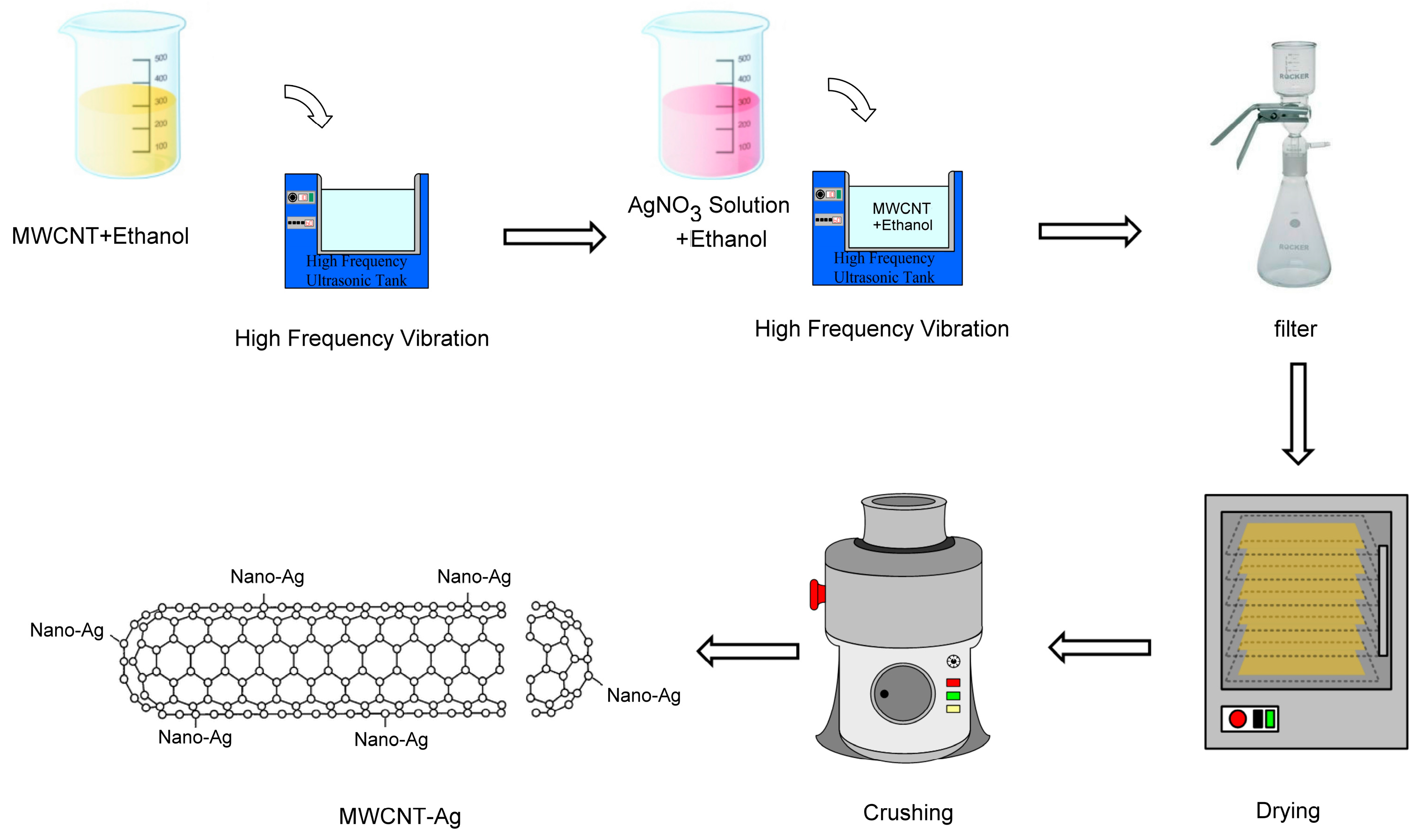
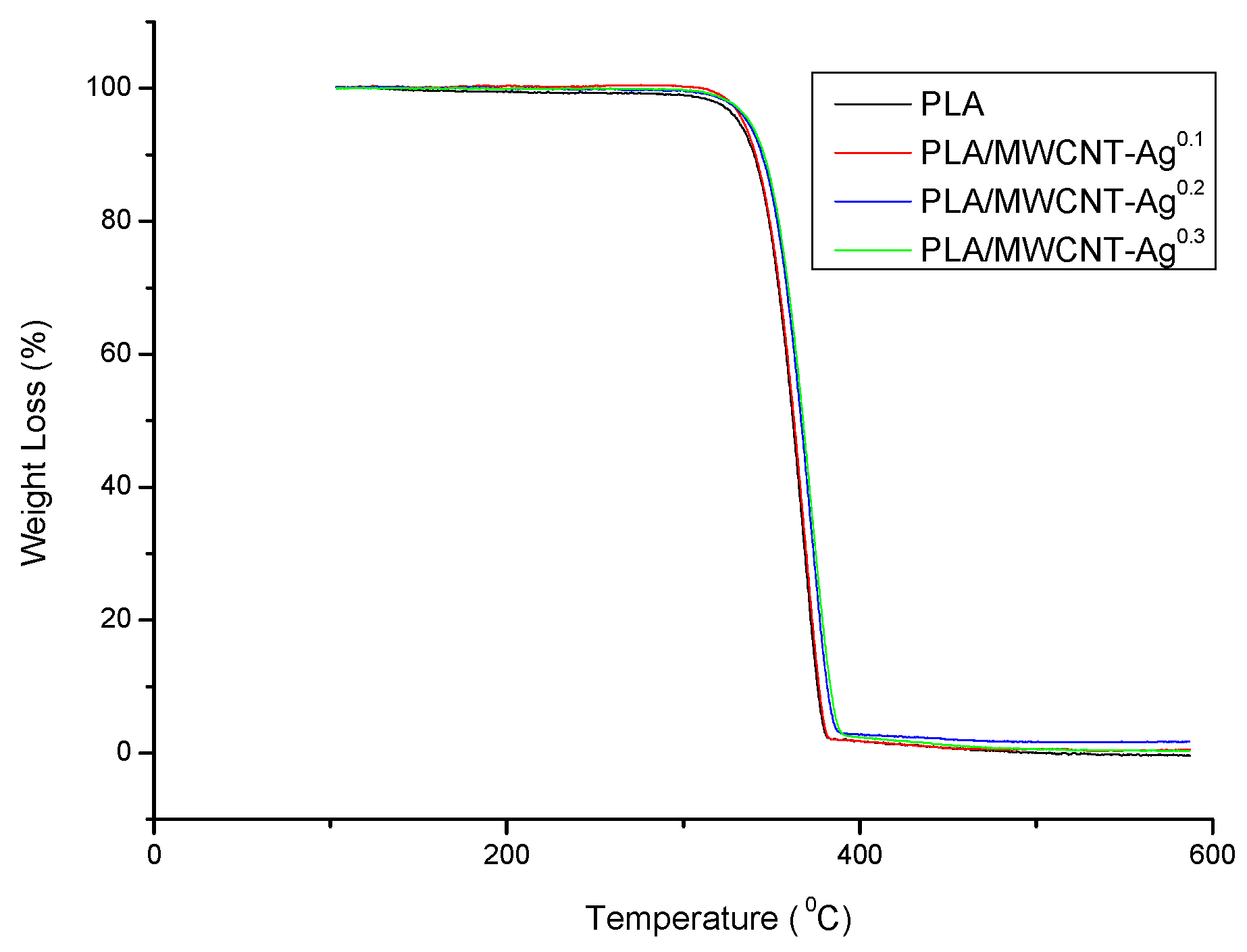
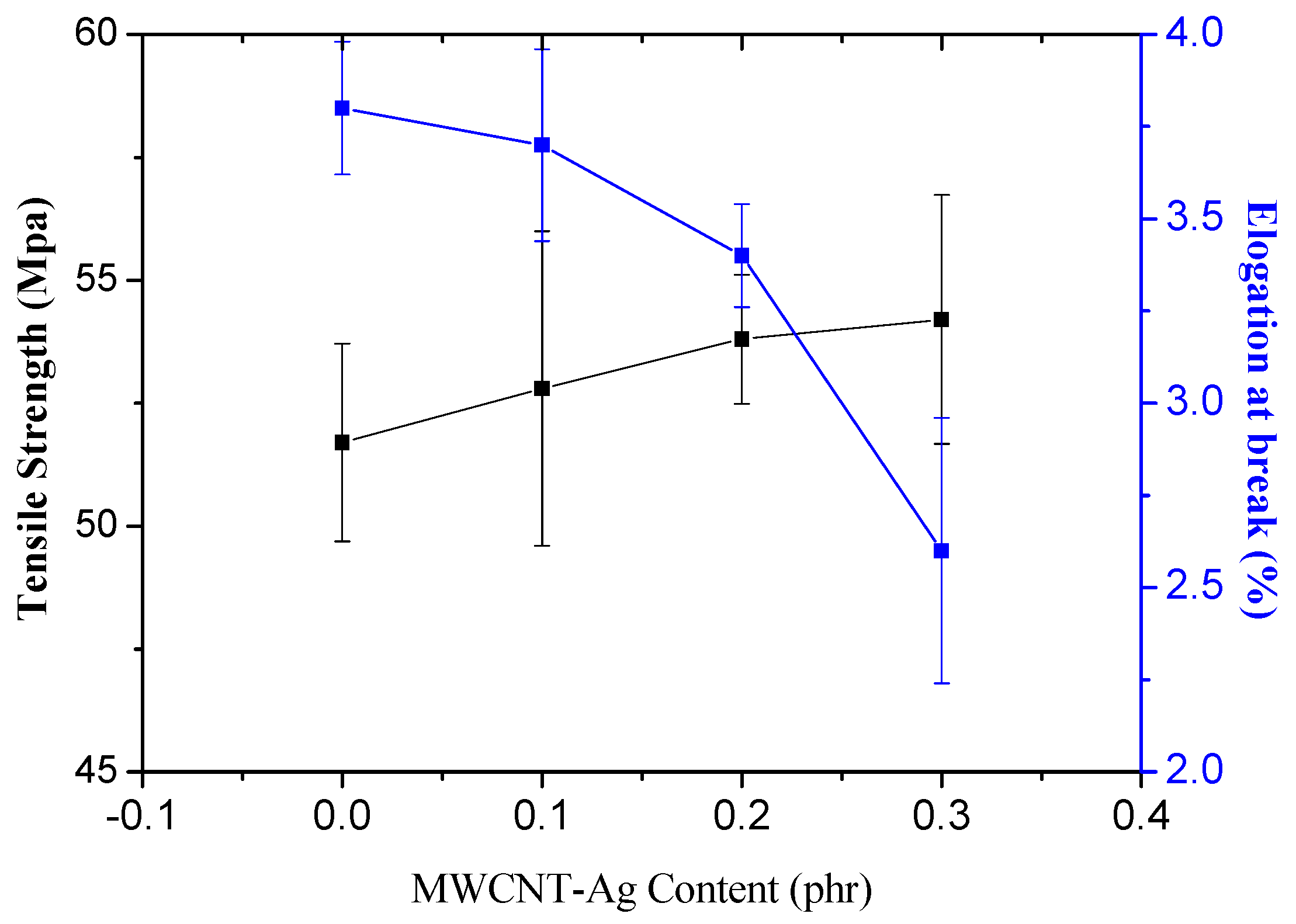





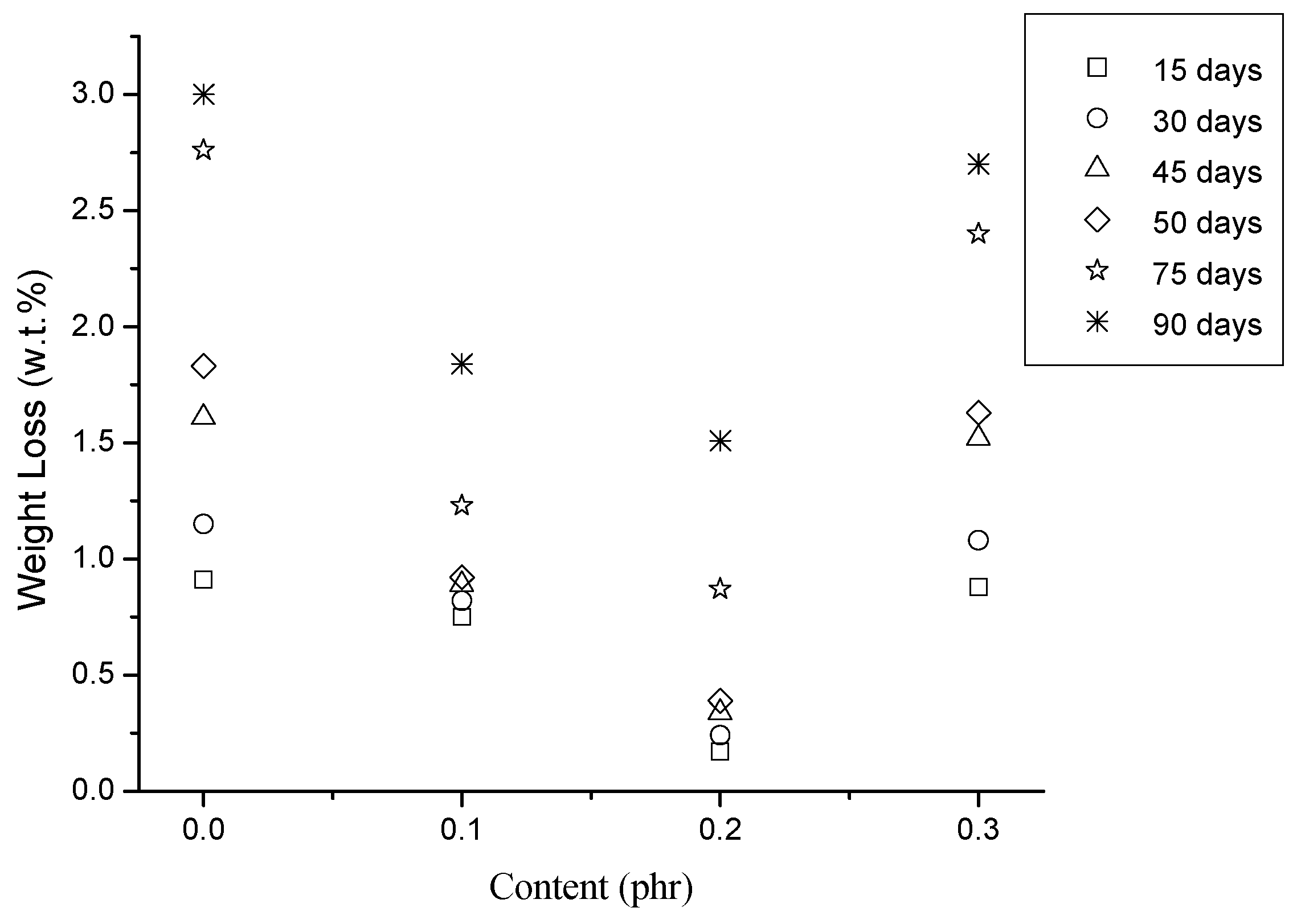
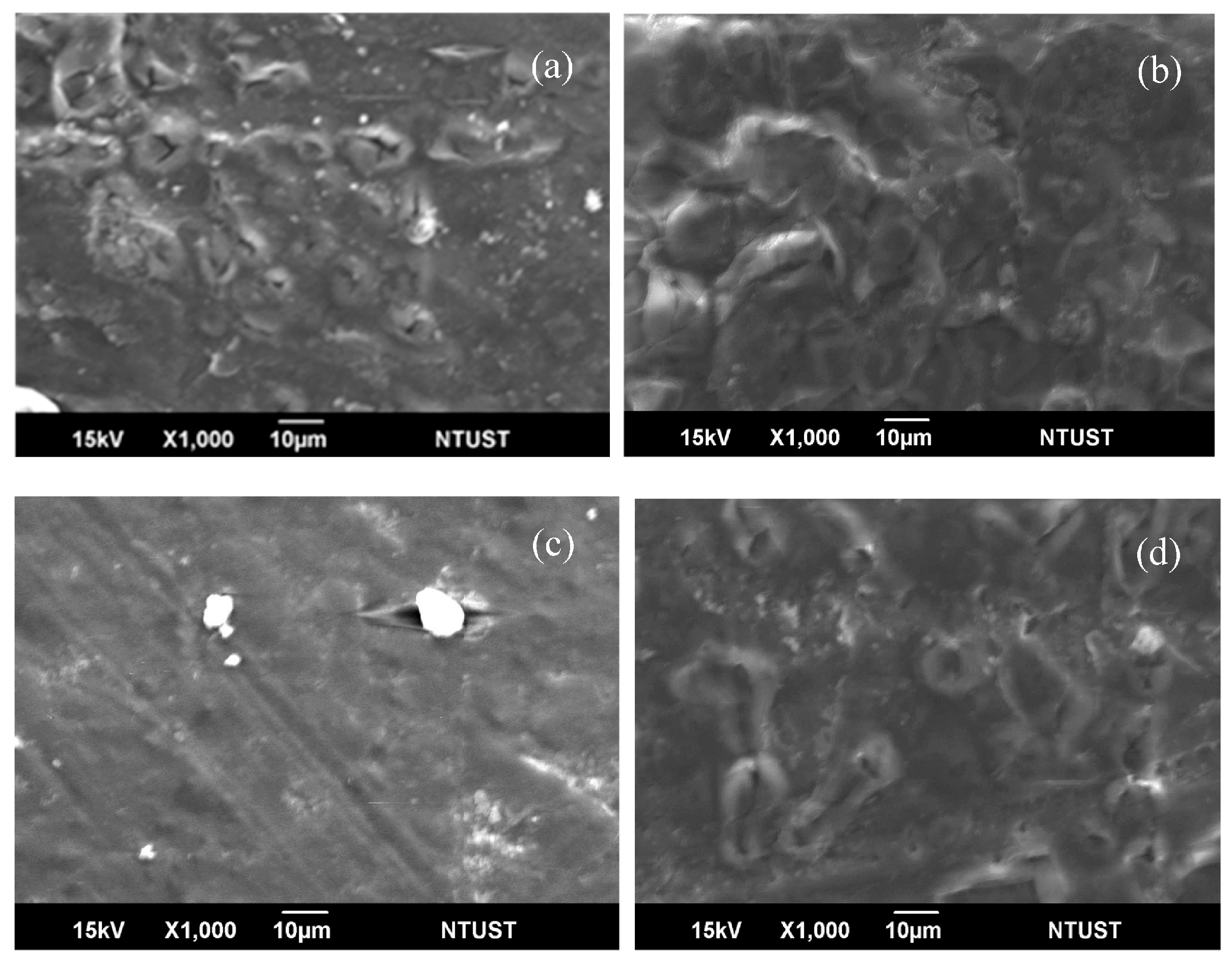
| Samples | PLA (g) | MWCNT-Ag (g) | BC content (Phr) |
|---|---|---|---|
| PLA | 50 | 0 | 0 |
| PLA/MWCNT-Ag0.1 | 50 | 0.05 | 0.1 |
| PLA/MWCNT-Ag0.2 | 50 | 0.1 | 0.2 |
| PLA/MWCNT-Ag0.3 | 50 | 0.15 | 0.3 |
| Samples | Tg (°C) | Tm (°C) | Xc (%) |
|---|---|---|---|
| PLA | 67.1 | 169.3 | 1.57 |
| PLA/MWCNT-Ag0.1 | 67.1 | 171.5 | 15.35 |
| PLA/MWCNT-Ag0.2 | 67.2 | 171.3 | 14.98 |
| PLA/MWCNT-Ag0.3 | 67.3 | 171.5 | 14.44 |
| Samples | Element | Weight (%) | Atomic (%) |
|---|---|---|---|
| MWCNT | C | 100.00 | 100 |
| Ag | - | - | |
| Totals | 100.00 | 100.00 | |
| MWCNT-Ag | C | 89.66 | 98.73 |
| Ag | 10.34 | 1.27 | |
| Totals | 100.00 | 100.00 |
© 2017 by the authors. Licensee MDPI, Basel, Switzerland. This article is an open access article distributed under the terms and conditions of the Creative Commons Attribution (CC BY) license ( http://creativecommons.org/licenses/by/4.0/).
Share and Cite
Tsou, C.-H.; Yao, W.-H.; Lu, Y.-C.; Tsou, C.-Y.; Wu, C.-S.; Chen, J.; Wang, R.Y.; Su, C.; Hung, W.-S.; De Guzman, M.; et al. Antibacterial Property and Cytotoxicity of a Poly(lactic acid)/Nanosilver-Doped Multiwall Carbon Nanotube Nanocomposite. Polymers 2017, 9, 100. https://doi.org/10.3390/polym9030100
Tsou C-H, Yao W-H, Lu Y-C, Tsou C-Y, Wu C-S, Chen J, Wang RY, Su C, Hung W-S, De Guzman M, et al. Antibacterial Property and Cytotoxicity of a Poly(lactic acid)/Nanosilver-Doped Multiwall Carbon Nanotube Nanocomposite. Polymers. 2017; 9(3):100. https://doi.org/10.3390/polym9030100
Chicago/Turabian StyleTsou, Chi-Hui, Wei-Hua Yao, Yi-Cheng Lu, Chih-Yuan Tsou, Chin-San Wu, Jian Chen, Ruo Yao Wang, Chaochin Su, Wei-Song Hung, Manuel De Guzman, and et al. 2017. "Antibacterial Property and Cytotoxicity of a Poly(lactic acid)/Nanosilver-Doped Multiwall Carbon Nanotube Nanocomposite" Polymers 9, no. 3: 100. https://doi.org/10.3390/polym9030100





